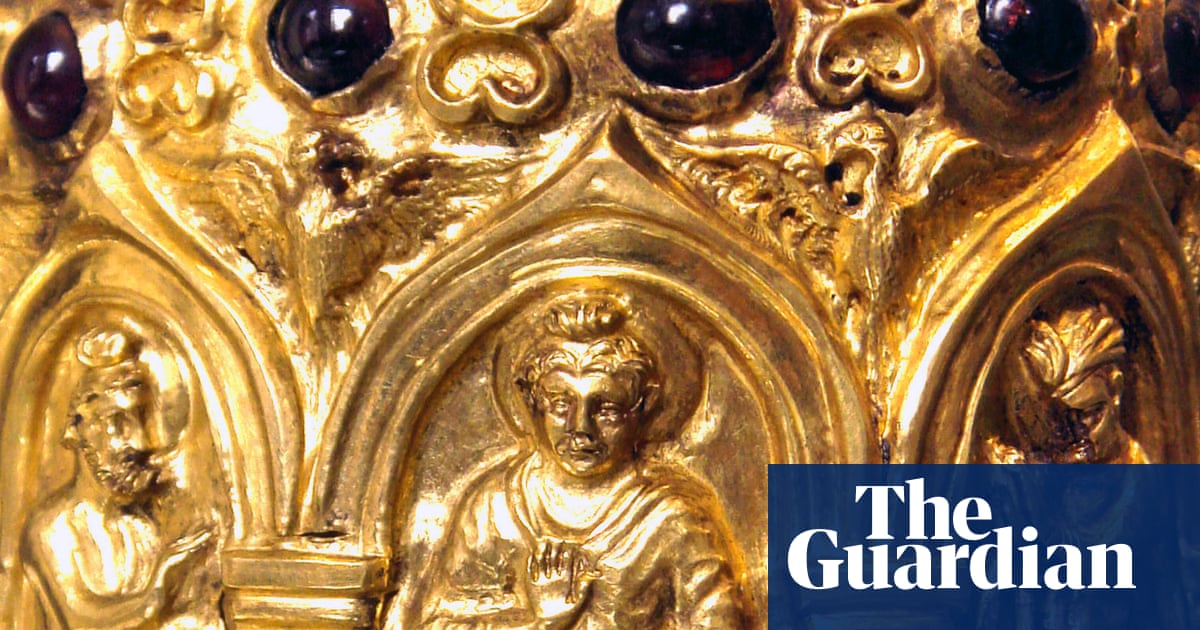Alexandria by Edmund Richardson review – the quest for the lost city
Show caption The solid-gold, garnet-encrusted Bimaran casket discovered by Masson is one of the British Museum’s greatest treasures. Photograph: CPA Media Pte Ltd/Alamy History books Alexandria by Edmund Richardson review – the quest for the lost city The mystery of a trailblazing archeologist who faked his own death is finally unravelled William Dalrymple Thu 27 May 2021 10.00 BST Share on Facebook
Share on Twitter
Share via Email
In the hot summer of 1840, the young orientalist Henry Rawlinson arrived in Karachi and began anxiously searching for his mentor, the pioneering archaeologist of Afghanistan, Charles Masson. The rumours he had heard profoundly alarmed him.
Rawlinson was a rising star: he had recently made his name by helping decipher ancient Persian cuneiform script; but he looked up to Masson as a far greater scholar. For more than a decade, Masson had wandered, alone and on foot, exploring Afghanistan, collecting coins and inscriptions, studying ruins and making sketches.
The bilingual Hellenistic coins Masson had sent to Calcutta, minted by men with names such as Pantaleon, King of North India and Demetrius Dharmamita, had been like miniature Rosetta stones. They had provided the key for scholars to understand the profoundly hybrid, Greco-Buddhist ancient history of the region. The coins of Heliochles of Balkh were typical: they showed a Roman profile on one side – large nose, imperial arrogance in the eyes – but on the reverse Heliochles chose as his symbol a humped Indian Brahmini bull.
Masson had also been the first western archaeologist to visit the ancient cities of Harappa and Mohenjo Daro. It was he who had first made known the lost Hellenistic Buddhist golden age of Gandhara by digging up what are still the earliest extant images of the Buddha. His most spectacular find was the solid-gold, garnet-encrusted Bimaran casket that is now one of the British Museum’s greatest treasures. Here classical figures of the Buddha stand under arcades of round arches, muscles rippling beneath the diaphanous folds of his toga. He stands with half-closed eyes, his hair oiled and groomed into a topknot; his face is full and round; and the lips firm and proud – the Buddha cast in the form of Apollo.
Above all, Masson had done more than anyone else to uncover the traces left by Alexander the Great in Afghanistan and to identify, in the Shomali plain outside Kabul, the site of the legendary lost city of Alexandria Beneath the Mountains. For Rawlinson, as for many subsequent scholars, Masson was a true trailblazer and hero.
Yet for all his extraordinary achievements, Masson remained an enigma. Despite clear traces of a Cockney accent, he claimed to be “an American gentleman from Kentucky”. This was a cover story that few believed, and Masson had recently been imprisoned by the East India Company on suspicion of spying when he was picked up wandering, without papers, on the borders of Afghanistan. The company kept him in half-starved solitary confinement for six months, on an occasional diet of stale bread and sheep entrails, something that seems to have come close to unhinging him.
Certainly, when Rawlinson finally ran Masson to ground in the backstreets of Karachi, he was horrified by what had happened to the man he had long revered as the greatest archaeologist of his day: “I rode into the town to see Masson of whom I have heard and read so much,” Rawlinson wrote in his diary. “I found him in a wretched hovel talking with some Belochees nearly naked and half drunk. I remained with him several hours and was extremely pained with all I witnessed. His language was at first so insolent that I thought he had become quite foolish. I think that his mind is really giving way.”
Masson’s story has fascinated generations of writers, and he weaves his shadowy way through many books about Central Asia, from Peter Hopkirk’s The Great Game to Rory Stewart’s The Places in Between. When I was researching my own Return of a King: The Battle for Afghanistan 1839-42, I came across a stash of Masson’s letters in the Indian National Archives. It was clear that he was in detailed and confidential correspondence with two of the grand masters of Central Asian espionage, Claude Wade and Alexander “Bukhara” Burnes. I remember thinking at the time what a wonderful book his story would make, encompassing as it does the wilder shores of archaeology, exploration and the cloak-and-dagger of Great Game spycraft. But so much about Masson was unclear, and in my books, as so often before, Masson remained a fascinating figure on the margins of the main tale, eclipsed in death, as he was in life, by better known, better connected and more powerful men.
Only now, with this superb biography, is Masson’s tale told in full for the first time. The result, evocatively written, impeccably researched and minutely footnoted, but with the pace and deftly woven plot complexity of a John le Carré novel, is a small masterpiece. It solves most of the mysteries of Masson’s story and deserves all the acclaim it will undoubtedly win.
The story Richardson has painstakingly reconstructed from archives in three continents tells a very different tale to that put about by Masson himself. Masson’s real name, it turns out, was James Lewis of the Bengal artillery. He was a self-taught working-class Londoner who had enlisted in the army of the East India Company. Then in 1827 he faked his own death at the Siege of Bharatpur and disappeared into the night. He wandered as a fakir through Hindustan, skirting Mughal Delhi to avoid attention. Somehow he made his way northwards from Bikaner through the profound emptiness of the Thar desert, before reappearing, starving, blistered and peeling, at the court of Bahawalpur, in what is now Pakistan.
There Masson was recruited into a mercenary force being formed by the American adventurer Josiah Harlan, the self-styled Prince of Ghor and one of Rudyard Kipling’s models for The Man Who Would Be King. Harlan aimed to reconquer Afghanistan for the ousted king, Shah Shuja ul-Mulk, but the expedition quickly fell apart and Masson was left alone and friendless in the middle of war-ravaged Afghanistan. Here he was soon robbed of most of his possessions and even his clothes. He was unable to return to India where he was a wanted man – the company had condemned him to death for desertion – so he had no choice but to beg his way to Kabul, where he calmly began his historical researches.
Under the protection of the highly intelligent and curious Crown Prince of Kabul, Akbar Khan, and armed with a copy of Arrian’s Life of Alexander the Great, Masson became the first westerner to explore Afghanistan’s ancient archaeology. Following in Alexander’s footsteps, he methodically excavated Buddhist stupas and Kushan palaces and before long had located the remains of the lost Alexandria.
It was here that Masson’s diggings really began to bear fruit: “Before the commencement of winter, I had accumulated one thousand eight hundred and sixty- five copper coins,” he wrote, “beside a few silver ones, and many rings, signets and other relics.” Coin after coin had the same words stamped on it in ancient Greek: “Basileus Basileon”, “King of Kings”; yet these were clearly Buddhist coins and many of them were turning up in buildings that appeared to be Buddhist monasteries. Dutifully, Masson began sending the pick of his finds down to the new Asiatic Society in Calcutta. Slowly the story of the Buddhist Bactrian Greeks began to come together.
It was his former mercenary commander, Josiah Harlan, who tipped off the authorities about Masson’s past. When the East India Company spymaster, Claude Wade, learned the secret of Masson’s real identity as an EIC deserter, he blackmailed him into becoming an “intelligencer”, dangling both the threat of capital punishment and the lure of a pardon. It did not end well. Once Masson was associated with the company, he became a marked man. He was finally forced to leave Kabul in 1839, just before the company blundered into the catastrophe of the first Anglo-Afghan war.
Masson’s political advice and intimate knowledge of Afghanistan were ignored. The result was a conflict which its first historian described as “a war begun for no wise purpose, carried on with a strange mixture of rashness and timidity, brought to a close after suffering and disaster, without much glory attached either to the government which directed, or the great body of troops which waged it. Not one benefit, political or military, has been acquired.”
Masson made it back to England, only to die in poverty near Potters Bar, Hertfordshire, in 1853 “of an uncertain disease of the brain”. He was buried in an unmarked grave. Both his priceless finds and his scholarly discoveries were appropriated by the company, and it is only now that his full achievement has finally become clear. Richardson writes at the end of his heartbreaking book: “No statues were ever set up to Masson. No marble mausoleums were erected. Not even a portrait survives.” But with the publication of this utterly brilliant biography he now has, at last, a fitting memorial.
• Alexandria: The Quest for the Lost City is published by Bloomsbury (£25). To support the Guardian, order your copy at guardianbookshop.com. Delivery charges may apply.










